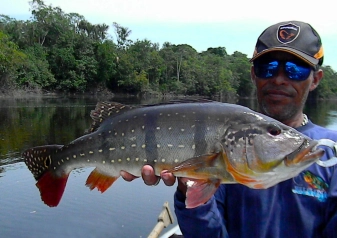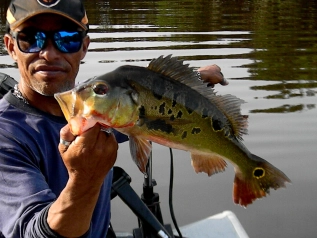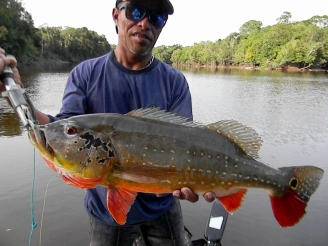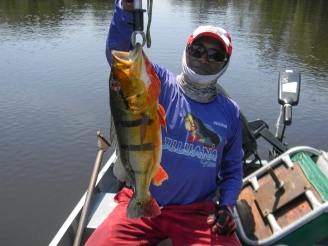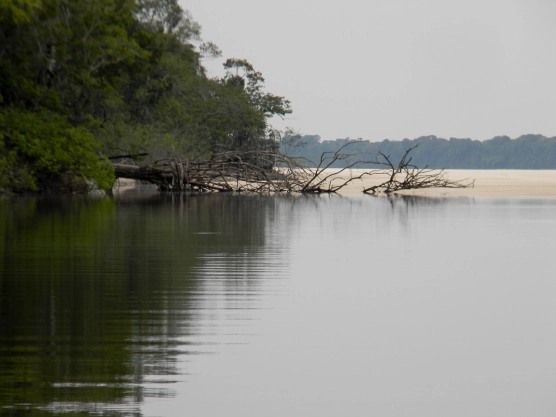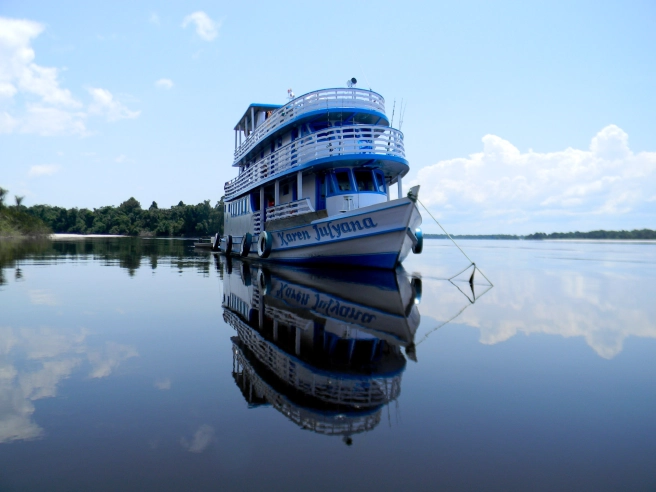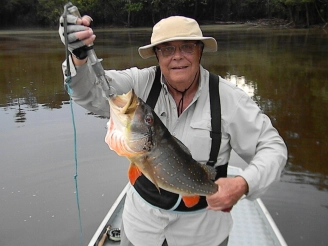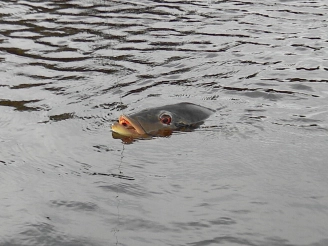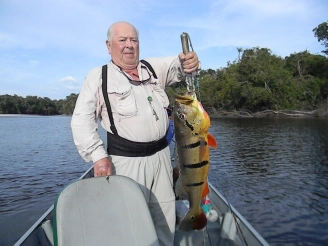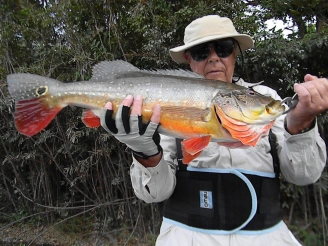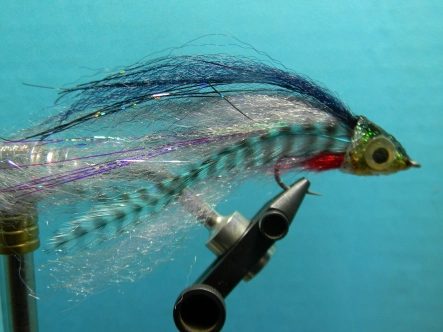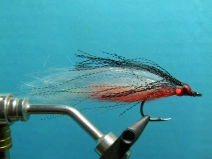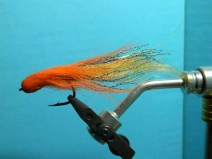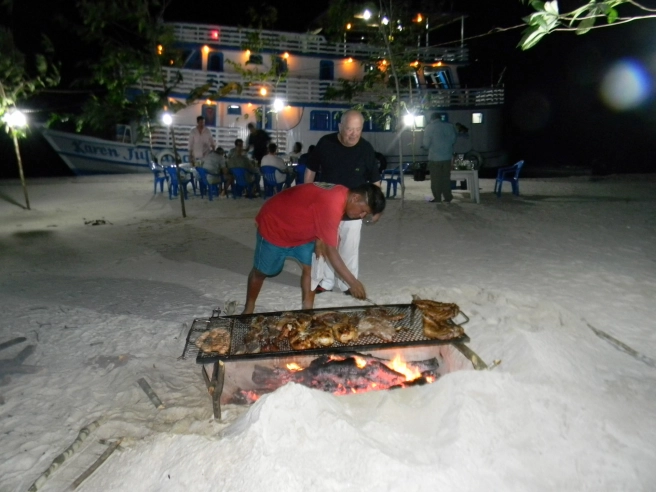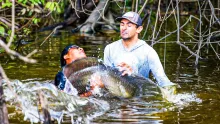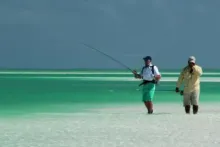The Amazon fresh water system, the largest in the world, is home to the Peacock Bass - a hard striking tropical fish.
“Filho” (pronounced feeleeo) whispered our guide and pointed at a half meter diameter circle of what looked like sparkling water in the middle of the quiet lagoon. My angling friend, with whom I was sharing the boat today, an experienced Amazon angler, immediately cast his fly just beyond the circle and to one side. A couple of strips and wham, fish on. After a few minutes fight he landed a beautiful 4 kilo Peacock Bass (Tucunaré as it is known locally). After releasing the fish, he explained: filho is son or offspring in Portuguese and the bubbling was caused by young Tucunaré frolicking on the surface, Momma and Poppa were below guarding their young. At the first sign of danger the young flee into Momma’s mouth and Poppa attacks the threat.
We were fishing about a half hour skiff ride from the mother ship that was anchored in the Rio Negro, about 250 km northwest of the town of Barcelos where we had embarked on the Karen Julyana, a typical Amazon steamer. We were about 400 or 500 kilometers south of the Brazilian/Venezuelan border and at the furthest point of our expedition.
Largest in the world
The Amazon fresh water system, the largest in the world, is home to the Peacock Bass, a member of the chichia family of which there are more than a dozen sub-species of the hard striking tropical fish. Known as the Tucunaré in Brazil and Pavón in Venezuela and Colombia, fly-fishing for this great predator has become very popular and several operators offer trips to try your hand with this beautiful game fish.
Most trips start with a stop off in Manaus, in the heart of the Amazon forest on the north bank of the Rio Negro close to where it joins the Solimoes River where, according to some, the Amazon River is born.
Manaus (population of over 2 million) started as a fort built in the late 17th century and became the richest city in South America in the late 1800’s thanks to the harvesting of natural rubber, referred to as Ouro Preto (Black Gold) in Portuguese. Fortunes were made and spent on making it a beautiful and sophisticated city, the Manaus Opera is world famous, during the golden years Enrico Caruso and other famous opera singers performed on its stage. Some of the opulent mansions are still there.
The Karen Julyana
On the 24th October 2015 I was one of 14 anglers from Córdoba in Argentina that arrived in Manaus by plane after a 2700 km flight from Sao Paulo and from there, flew for a little over an hour NW on a twin turboprop to Barcelos, where we boarded the river steamer, the Karen Julyana, with 8 air-conditioned double cabins with bathrooms. We were starting a six day trip fishing for Peacock Bass on the Rio Negro, it was my first and hopefully not my last trip to the Amazon.
As soon as we embarked the Karen Julyana set out upriver followed by a smaller boat carrying staff, guides, supplies and towing 7 fishing skiffs with 40 hp outboard and electric motors for two anglers and a guide. After assigning cabins and settling in, a well catered lunch followed by a short nap, the ship moored on the Rio Negro, the skiffs came along side and we boarded them to start fishing.
At this time of the year the water is low and therefore access to many of the lagoons was restricted. On occasions the outboard motor was left at the side of the openings to lighten the skiff and the guide would push us through shallow and log strewn streams until reaching the open iodine colored water of the lagoons where we were propelled by the electric motor.
Plentiful wildlife
The wildlife was plentiful, birds of numerous species including big beaked Tucans, majestic Storks, Egrets, Kingfishers, noisy Parrots and other colorful birds kept us company, in the evenings starling like birds would entertain us with their aerobatics catching insects in flight. Giant otters, monkeys and White lipped Peccary, Caimans and fresh water dolphins were seen all the time. The dolphins (locally called Boto) were always around waiting to steal our catch, on one occasion our guide had to shoo it away with his paddle to let us land a 5 kilo Tucunaré. It is said that they even wait a catch beneath the boat. The caimans also follow the boats waiting for the opportunity to have an easy meal. One of my friends filmed a big caiman swallow his catch, fly and all and had to cut the line. Another used his baitcast lure to snag a smaller caiman.
We fly fished exclusively
Most Brazilian anglers fish with Baitcast gear, and some of my angler friends brought both baitcast and fly gear. Some also brought heavy big game fishing gear to attempt catching one of the giant catfish and Arapaima that can weigh well over 100 kilos.
Myself and several others fly fished exclusively. We used # 8 or 9 weight rods with tropical lines, both floating and intermediate sinking tips with 60 lb fluorocarbon leaders and 30 to 50 lb nylon tippets. The flies are large, tied on strong 3/0 to 5/0 hooks, light colours, white, red, orange, yellow, etc. with plenty of flash. As the tippets are pretty rigid, the flies are attached with a loop for better movement. My most successful fly was a Clouser Deep Minnow design (see pictures) tied on a 4/0 hook. The leader and tippet have to be hefty as when the Tucunaré takes and feels the hook, will head for the cover of the logs and branches in water close to shore and you have to keep it from getting there as otherwise the line will snag and both fish and fly will be lost.
Tucunaré (Rainbow Bass)
Our main target was Tucunaré (Rainbow Bass) in its several sub varieties, the Azu with vertical stripes down its body, the Borboleta with large circles, the Paca with speckles, the Amarelinho and the Azupaca the result of crossbreeding between the Azu and the Paca. All have a circle on their tails. Several other varieties took our flies, Aruana, Jacunda, Traira (Wolf fish) and Picuda. Plenty of Piranha, their sharp teeth clipped flies and I lost a nice Tucunaré when a Piranha attacked the knot in my leader.
As with the fresh water Dorado they wait in ambush amongst the logs that have fallen in the water and hefty strip strikes are needed to set the hook. When the fly is followed fast stripping will invite a strike. Another spot where they hunt is close to sand banks, in these cases I would put the fly on the sand bank at the edge and slowly strip it into the water. Most of my catches were with streamers, some weighted or with a small lead shot at the end of the tippet. Did catch a couple with poppers, fast stripping is needed to catch their attention so I would put the rod under my arm and strip with both hands. The fish were numerous, most in the 1 to 3 kilo range. In one spot, nine consecutive casts caught nine fish. My best catch was a 6 kilo Paca but several 10 kilo fish were taken by my friends. The smaller fish fight close to the surface and offer acrobatic leaps but the big ones dive deep. I was told that Tucunaré of over 13 kilos have been taken on the fly.
We passed several settlements where the villagers live off capturing ornamental tropical fish for aquariums or harvesting palm fiber for heavy duty brooms. Some travel for days down-stream to get their products to market and purchase supplies.
Up at 5:30
Our day would start at dawn with a wake-up call at 0530, a hearty breakfast and the skiffs would be alongside at 0600. After a half hour ride through the tributaries of the Rio Negro we would fish the sand banks, log strewn banks of the streams and rivers or a quiet lagoon until about 1100. Back to the ship for a shower and drinks, lunch and a brief nap and at 1500 we would be fishing again until 1800, back to the ship for drinks on deck and an early dinner in the air-conditioned dining room.
One evening the ship moored alongside a sand bank where the crew prepared a barbecue ashore (Luau as they referred to it) and we dined on pork ribs, sausages and salads on tables with electric lights from the ship strung on branches they had cut and stuck in the white, very fine sand. We bathed in the river. No bugs as the acidic waters preclude the reproduction of mosquitos, gnats and other bothersome bugs.
Practical tips
I wore light colored and light weight tropical clothing, long sleeve shirts, long trousers, wide brimmed hat, dark glasses, fishing gloves and plenty of sunblock. Shorts and T shirts for use on board and a bathing suit.
I only drank bottled water and used it to brush my teeth. I took, but did not use, medicines including antihistamines, wide spectrum antibiotics, etc. The sort of selection one would take for a week far away from a pharmacy. We packed light as there are weight restrictions on the flight from Manaus to Barcelos. Our clothes were washed aboard. Nevertheless several changes were needed. The temperatures were about 35 to 38º Celsius but it is very humid and I had to change clothes at noon. Most outfitters will supply a list for newcomers.
Useful links
www.pescaembarcelos.com.br
- Log in to post comments

